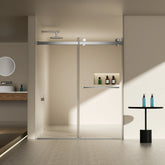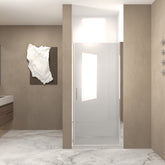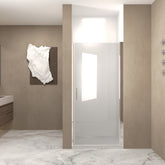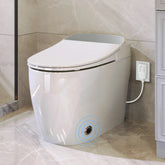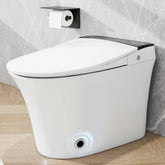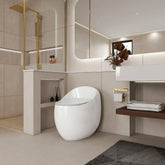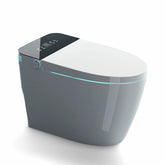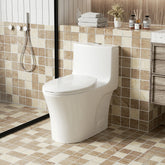Smart Toilet Buying Guide: What to Look for in 2025
1. Introduction: Why Smart Toilets Are No Longer Optional in 2025
Over the past few years, I’ve seen a noticeable shift in how we think about our homes—especially the bathroom. In 2025, smart toilets have moved from being a luxury upgrade to an everyday essential. It’s no longer just about having a sleek design or futuristic functions—it's about meeting new standards of hygiene, convenience, and sustainability.
The lifestyle changes brought on by the COVID-19 pandemic pushed us to pay more attention to cleanliness and contactless living. That’s when I started exploring smart toilet features like automatic flushing, self-cleaning nozzles, and touchless lids. These aren’t just gimmicks—they’re practical tools for a cleaner, safer bathroom experience.
More than ever, I value comfort in my daily routine. Features like heated seats, adjustable bidet spray, and warm air drying have transformed how I view personal hygiene. And let’s not forget the night light—a small detail, but a game-changer for nighttime use.
Another big factor for me is sustainability. Traditional toilets use a surprising amount of water and encourage excessive toilet paper use. Smart toilets with water-saving flush systems and built-in bidets have helped me cut down on both—making my home a bit greener in the process.
Ultimately, I see smart toilets as the new centerpiece of modern bathrooms. They combine technology, comfort, and cleanliness in ways that simply make sense. And as we move further into 2025, I believe every household should consider making the switch.

2. Core Features You Should Look For (Must-Have Functions)
When I began researching smart toilets, I quickly realized that not all features are created equal. Some are nice to have, while others are truly essential for daily comfort and hygiene. Here are the core functions I believe every smart toilet in 2025 should include—these are the features that genuinely make a difference in everyday use.
Heated Seat
This might sound like a luxury at first, but trust me, once you experience a heated seat on a cold morning, there’s no going back. It’s one of those simple features that brings comfort into your routine without you even noticing—until it’s gone.
Bidet with Adjustable Spray
A built-in bidet with adjustable water pressure and temperature is the heart of any smart toilet. It offers a superior level of cleanliness compared to traditional toilet paper and is far more gentle on the skin. Plus, it helps save trees by reducing toilet paper use—a win for both hygiene and the environment.
Automatic Flushing & Lid
This was one of the first features that caught my attention. Automatic flushing and lid opening/closing mean less contact with surfaces—especially important for maintaining hygiene. It’s great when you have guests, children, or just want a completely hands-free experience.
Self-Cleaning Nozzle
I used to worry about how clean the bidet nozzle really was—until I learned about the self-cleaning function. This feature automatically sanitizes the nozzle before and after each use, giving me peace of mind and reducing the need for manual cleaning.
Deodorizer
There’s nothing worse than an unpleasant smell lingering in the bathroom. That’s why I love built-in deodorizers. They activate automatically and keep the air fresh, making the bathroom feel more welcoming—especially in shared households.
Drying Function
The warm air dryer completely changed my routine. It dries gently and thoroughly, making toilet paper almost obsolete. It’s hygienic, eco-friendly, and adds an extra layer of comfort, especially after using the bidet.
Night Light
I never thought I’d need a night light on a toilet—until I got one. It provides just enough illumination for nighttime use without having to turn on bright overhead lights. It’s subtle, smart, and incredibly helpful.
In my experience, these must-have smart toilet features strike the perfect balance between functionality, comfort, and innovation. If you’re investing in a smart toilet in 2025, make sure these essentials are on your checklist.

3. Features That Sound Fancy… But May Be Optional
As I explored different smart toilet models in 2025, I came across plenty of features that looked impressive on paper—but didn’t necessarily add value to my daily routine. While some of these extras may appeal to tech enthusiasts or luxury homeowners, they’re not must-haves for most people. Here are a few smart toilet features that sound fancy, but in my opinion, are completely optional.
App or Voice Control
I’ll admit, the idea of controlling a smart toilet with Alexa or a smartphone app sounded futuristic and fun. But after trying it, I realized I rarely used it. Most of the key functions—like the bidet, dryer, or seat temperature—can be easily adjusted with the built-in remote or side panel. Voice control is nice to have, but not essential for daily use.
Remote Operation via Smartphone
Being able to flush or pre-warm the seat from my phone seemed convenient at first, but I honestly found little use for it. Unless you’re managing your bathroom from another room (or another floor), smartphone operation feels like overkill. It’s a cool talking point, but not something I rely on.
Health Monitoring Functions
Some of the latest high-end smart toilets offer health tracking features like urine analysis, body temperature monitoring, and hydration data. While the technology is impressive, I found it to be more niche than necessary. Unless you have specific medical needs or love health gadgets, this feature probably won’t justify the added cost.
Integrated Music/Speakers
Sure, built-in Bluetooth speakers or ambient music features sound luxurious. But in reality, I already have other devices for that. Playing music through a smart toilet is fun the first few times, but quickly becomes something I ignore. It’s definitely a luxury—not a priority.
Auto Seat Adjustment Based on User Profile
This feature allows the toilet to recognize different users and automatically adjust settings like seat height or spray angle. While that might be handy in a large household with specific preferences, I personally found it a bit excessive. Most people don’t need this level of automation unless the toilet is shared by many users with vastly different needs.
Bottom line: while these high-tech features can enhance the experience, they aren’t essential for most homeowners. I’d recommend focusing your budget on the core smart toilet features that offer real, everyday value. The rest? Nice to have—but not necessary.

4. Price Range: What Should You Expect to Spend?
When I first started looking into buying a smart toilet, I was surprised by how wide the price range could be. From basic models with just a few upgrades to premium toilets packed with high-end tech, the options can fit almost any budget—as long as you know what you're paying for. Here’s how I break down the pricing tiers based on features and value in 2025:
Basic Models ($300–$800)
If you’re just getting started with smart toilets, this is a great entry point. Basic models usually include heated seats, adjustable bidet spray, and sometimes a drying function. These essentials cover most of what I use daily, and they’re perfect for upgrading without a huge investment. However, don’t expect advanced features like auto flushing or self-cleaning nozzles at this price point.
Mid-Tier Models ($800–$1,500)
This is the sweet spot for most homeowners, and honestly, it’s where I ended up. Mid-range smart toilets usually offer all the core features I talked about earlier: self-cleaning nozzles, automatic flushing, deodorizers, and sometimes even night lights. These models strike a great balance between comfort and price, making them ideal for people who want an all-around upgrade without splurging.
Premium Models ($1,500–$3,000+)
If you're ready to go all in, premium smart toilets have it all. I’m referring to app control, personalized user profiles, health tracking features, and advanced air drying systems. Some even come with touchscreen remotes or voice assistant integration. While I loved testing these high-end features, I found that they cater more to luxury homeowners or tech enthusiasts.
Installation Costs and Other Considerations
One thing I didn’t expect was the extra cost of installation. Many smart toilets—especially mid to premium models—require a nearby electrical outlet. If your bathroom doesn’t already have one near the toilet, you may need to hire an electrician. Additionally, professional installation is recommended for models with more complex plumbing or wiring needs, which can add a few hundred dollars to your total cost.
In short, your budget will determine which features you can prioritize. But even the most basic smart toilets offer major improvements over traditional ones. It all comes down to how much comfort, convenience, and tech you're looking to bring into your bathroom.

5. Future Trends in Smart Toilets (2025 and Beyond)
As someone who’s fascinated by bathroom technology, I can’t help but look ahead at where smart toilets are going. The models we have in 2025 are already impressive, but the future holds even more groundbreaking innovation. If you're planning a long-term bathroom upgrade, it's worth knowing what trends are just around the corner. Here are a few smart toilet advancements I’ve been keeping an eye on:
AI-Enhanced Personalization
Artificial intelligence is making its way into every part of the home—and the bathroom is no exception. Shortly, I expect smart toilets to learn user preferences automatically. Imagine a toilet that adjusts the bidet spray pressure, seat temperature, and drying settings based on your past behavior. Some high-end models are already experimenting with this, and it’s only going to get smarter.
Integrated Health Diagnostics
One of the most exciting developments is health monitoring
Eco-Efficiency Advancements
Environmental concerns are influencing every corner of design, and smart toilets are no different. We're seeing more models with dual-flush systems, water-saving bidets, and even waterless waste processing for off-grid or sustainable homes. I appreciate these features—they reduce water consumption without sacrificing comfort or cleanliness.
Smart Home Ecosystem Compatibility
As smart homes become more integrated, toilets are joining the conversation. Some smart toilets can already connect to Google Home or Amazon Alexa for voice commands or status updates. Shortly, I envision a fully connected bathroom where the toilet, shower, lights, and ventilation systems all communicate and adapt based on your preferences. It sounds futuristic—but it’s becoming reality fast.
Compact and Wall-Mounted Designs
For those with smaller bathrooms like mine, space-saving designs are a game changer. Manufacturers are developing wall-mounted smart toilets that combine modern aesthetics with functionality, without taking up unnecessary room. These designs also make cleaning the floor much easier—something I didn’t realize I’d love until I tried one.
In short, the future of smart toilets is about more than just comfort—it's about intelligent personalization, health, sustainability, and seamless integration into our daily lives. If you're considering investing in a smart toilet now, you're stepping into a rapidly evolving world of bathroom innovation. And honestly, I’m here for it.

6. Conclusion
After diving deep into the world of smart toilets, I can confidently say that these advanced fixtures are no longer just high-tech novelties—they’ve become a practical, everyday essential. Whether it's the enhanced comfort of a heated seat, the hygiene benefits of a built-in bidet, or the hands-free convenience of automatic flushing, smart toilets are redefining what we expect from a modern bathroom in 2025.
From my experience, the key to choosing the right smart toilet is to focus on the features that truly match your lifestyle. Start with the must-have functions—like self-cleaning nozzles, drying systems, and deodorizers—and think carefully before splurging on fancy add-ons that may sound exciting but offer limited real-world value.
I also learned the importance of buying from trusted smart toilet brands and using certified installers—especially for models that require electrical connections or advanced plumbing. A quality installation ensures all those high-tech features work smoothly and safely from day one.
In the end, I believe smart toilets represent a smart investment. They bring together comfort, hygiene, sustainability, and innovation—all in one fixture. If you’re upgrading your bathroom in 2025, don’t think of a smart toilet as a luxury item. Think of it as the new standard.
Featured Products
AISU Smart Bidet Toilet with Remote Control.Raised Tankless Toilet with LED Display
- $522.68
- $522.68
- Unit price
- / per
AISU One Piece Heated Seat Smart Toilet, White
- $364.79
- $364.79
- Unit price
- / per
AISU Smart Toilet with Foot Sensor Flush, Blue Night Light, White
- $366.72
- $366.72
- Unit price
- / per
AISU One-Piece 1.28 GPF Single Flush Egg Shape Toilet
- from $481.74
- from $481.74
- Unit price
- / per
-
Glossy White
-
Glossy Black
AISU Smart Toilet with Heated Bidet Seat, Portable toilet with bidet built in AUTO Open&Close, AUTO Dual Flush, Bidet toilet with Dryer and Warm Water, White
- $642.24
- $642.24
- Unit price
- / per
AISU 1.28 GPF Tornado Flush Two-piece Toilet for bathrooms, Gloss White
- $236.91
- $236.91
- Unit price
- / per
AISU 1.1/1.6 GPF Tornado Flush One-Piece Toilet Elongated, Siphonic S-trap 12", Soft Closing Seat, Button on Tank top, Powerful Dual Flush MAP 1000g, Comfort Chair Seat ADA Height 17", Glossy White
- $372.43
- $372.43
- Unit price
- / per
